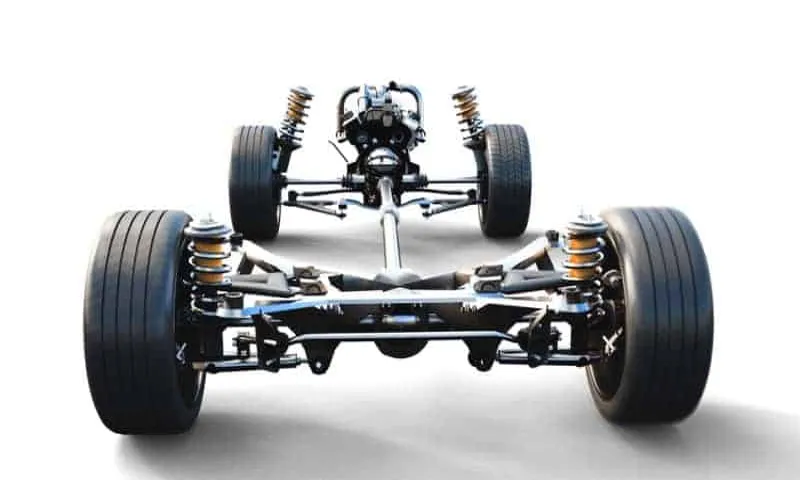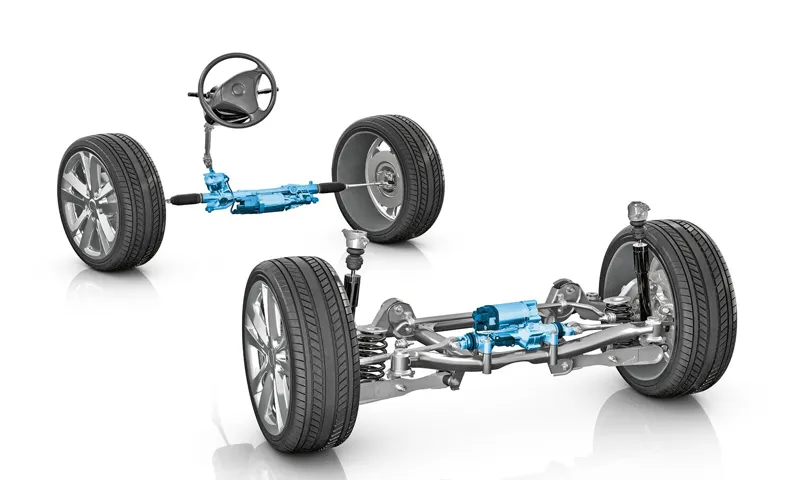Cars have been an integral part of human life for decades, and as time progressed, they have become more advanced and complex machines. But to truly understand how a car works, we need to explore its most fundamental components. One such component is the car’s axle, which plays a crucial role in its movement and stability.
If you have ever wondered, “How many axles does a car have?” you’re not alone. The answer may seem straightforward, but the truth is, it can vary depending on the type of car. Generally, a car has two axles, one in the front and one in the rear, with each axle having two wheels.
However, some cars may have more axles, like a tractor-trailer that can have up to five axles for heavy hauling. Axles are critical because they are responsible for transmitting torque from the engine to the wheels, allowing the car to move forward or backward. Without an axle, a car would simply be a stationary object.
In addition, the number of axles a car has can also determine how stable it is on the road, with more axles providing better balance and support. Next time you’re driving down the road, you can appreciate the role that axles play in keeping your car moving forward. Whether your car has two axles or more, they are an essential part of your car’s functionality and safety.
So, now that you know the answer to the question “How many axles does a car have?” let’s dive deeper into this fascinating component and learn more about how it works.
Table of Contents
Understanding Car Axles
Many people wonder how many axles are on a car, and the answer can vary depending on the type of car. Most cars have two axles, which means they have four wheels. However, some cars, such as trucks or buses, may have additional axles for added stability and weight distribution.
The number of axles also affects the car’s handling, as a car with more axles will have better traction and stability on the road. Additionally, axle design can vary, with some cars having independent suspension to allow each wheel to move separately, while others have a solid axle that keeps both wheels connected. It’s important to understand the different types of axles and their functions, as they play a crucial role in the overall performance and safety of a car.
Definition of Car Axle
A car axle is one of the most vital components in a vehicle’s drivetrain system. It connects the wheels to the transmission and allows them to rotate efficiently while also managing the weight of the vehicle. Essentially, an axle can be described as a rod or shaft that runs through the center of the wheel and connects the two sides of the vehicle.
Most cars have two axles – one in the front and one in the rear. The front axle is responsible for steering the wheels, while the rear axle provides power to the wheels. Both axles work together to transfer power from the engine to the wheels and keep the car moving.
Without axles, cars wouldn’t be able to function properly, making them an integral part of the modern transportation system.

Types of Car Axles
Car axles are an essential component of a car’s suspension system as they enable the wheels to rotate while also supporting the weight of the vehicle. There are two main types of car axles: front-wheel-drive axles and rear-wheel-drive axles. Front-wheel-drive axles usually have a shaft that is connected to the transmission and differential on each side, which then powers the front wheels.
These axles often have constant velocity (CV) joints that help to transfer power from the transmission to the wheels while allowing for some flexibility and movement during turns. Rear-wheel-drive axles, on the other hand, are different in that they have a single driveshaft that connects the transmission to a rear differential. The axles are then connected to the differential, which sends the power to the rear wheels.
In addition to these two types of axles, there are also all-wheel-drive axles that are designed for cars with a four-wheel-drive system. These axles can vary depending on the model of car, but they typically have a front and rear driveshaft that connect to the differential to power all four wheels. Understanding the different types of car axles can help you to better understand how your car works and what type of suspension system it has.
It is also important to note that axles can vary in size and strength, depending on the weight and performance of the car. Overall, car axles may seem like a small component of your car, but they are an important part that helps keep your vehicle moving efficiently.
Number of Axles on Different Types of Cars
Have you ever wondered, “how many axles are on a car?” Well, the answer depends on the type of car you’re talking about. For example, most ordinary cars will have two axles – one in the front that spins the front wheels, and one in the back that spins the back wheels. However, some larger vehicles, like trucks and buses, may have more than two axles.
These extra axles are used to distribute weight more evenly and increase the vehicle’s carrying capacity. Additionally, some high-performance sports cars may have four or even six axles for better handling and stability at high speeds. So, next time you’re admiring a car, take a look at its axles to get an idea of its size, weight, and purpose.
Sedans and Hatchbacks
When it comes to different types of cars, there are several distinguishing factors that set them apart. One such factor is the number of axles they have. Sedans and hatchbacks are two common car types that differ in the number of axles they possess.
Sedans, also known as saloons, typically have four wheels with two axles. This configuration provides a stable and comfortable ride, making it a popular choice for families and commuters. Hatchbacks, on the other hand, often have a similar four-wheel configuration but with the addition of a fifth door at the back.
This door typically opens upward to reveal a spacious cargo area, making hatchbacks ideal for those who need extra room for carrying luggage or equipment. Both sedans and hatchbacks have their unique qualities, making them suitable for different purposes and lifestyles. Nevertheless, regardless of how many axles they have, it is always essential to choose a car that meets your needs and preferences.
So, which one would you choose?
SUVs and Vans
When it comes to comparing SUVs and vans, one of the key factors to consider is the number of axles each vehicle has. SUVs typically have two axles – one in the front and one in the back – while vans generally have three. The extra axle in a van offers several benefits, including increased stability and weight capacity.
It can also provide better traction and handling, especially in poor weather conditions. However, this additional axle can also result in lower fuel efficiency and a higher cost of maintenance. Ultimately, the decision between an SUV and a van comes down to individual needs and preferences, as well as budget and usage requirements.
So, whether you’re looking for a reliable family vehicle or a spacious work van, be sure to consider the number of axles and how it may impact the performance and cost of your chosen vehicle.
Trucks and Trailers
When it comes to the number of axles in trucks and trailers, there are a few different types of vehicles that vary in their configuration. Firstly, there are straight trucks, which are often used for local deliveries. These trucks typically have two axles, one on the front and one on the back, which provide stability and allow for maneuverability in tight spaces.
Moving on to tractor-trailers, which are commonly seen on highways, and they have a minimum of three axles: two on the tractor and one on the trailer. The extra axle on the trailer provides extra support for heavier loads and reduces the wear and tear of the tires. Finally, there are specialized trailers, such as those used for transporting heavy equipment, which can have up to nine axles to evenly distribute the weight and prevent damage to the road surface.
Overall, the number of axles in a truck or trailer depends on the purpose of the vehicle and the weight of the load it’s carrying.
Why Number of Axles Matter
If you’re wondering how many axles are on a car and why it matters, you’re not alone. Most cars have two axles: a front axle and a rear axle. Each axle has at least one wheel attached to it, which transmits power from the engine to the wheels for propulsion.
The number of axles can influence a car’s stability, handling, and payload capacity. For example, a car with more axles tends to be more stable and can carry heavier loads. Additionally, a car with a higher number of axles may have better handling and cornering capabilities since the weight is distributed more evenly across the wheels.
However, more axles typically mean more weight and complexity, which can affect fuel economy and maintenance costs. So, when choosing a car or truck, it’s essential to consider how many axles you need based on the application and your driving preferences.
Impact on Vehicle Performance
When it comes to vehicle performance, the number of axles can make a significant difference. Axles are an essential component of any vehicle, as they help distribute weight and transfer power from the engine to the wheels. The more axles a vehicle has, the better the weight distribution and handling will be.
For instance, a car with a single axle will put a lot of weight on its two tires, leading to poor traction and stability on the road. On the other hand, a truck or bus with multiple axles will distribute the weight more evenly, providing better balance and improved traction. Additionally, more axles mean a higher payload capacity, which is the maximum weight a vehicle can carry.
In summary, the number of axles is crucial when it comes to vehicle performance, affecting weight distribution, handling, and carrying capacity.
Impact on Safety
When it comes to highway safety, the number of axles on a vehicle can make a big difference. Vehicles with more axles are generally considered safer than those with fewer. Why? Well, it all boils down to stability.
A vehicle with more axles has a wider base and is therefore more stable than one with fewer axles. This means that the likelihood of the vehicle tipping over is greatly reduced, especially when driving around corners. Additionally, vehicles with more axles are able to carry heavier loads without compromising stability, which is particularly important for large commercial trucks.
Overall, the number of axles on a vehicle is an important factor to consider when evaluating safety on the road.
Conclusion
In conclusion, the number of axles on a car may seem like a simple question, but it’s not as straightforward as you think. It all depends on the type of vehicle, its weight, and its purpose. Just like how we all have unique needs and abilities, cars come in all shapes and sizes, each with their own individual set of axles to get the job done.
So, next time someone asks how many axles are on a car, feel free to impress them with your newfound knowledge and remind them that cars are way more complex than we give them credit for. After all, a car isn’t just a car – it’s a masterpiece of engineering and design!”
FAQs
1. How many wheels does a typical car have and how many axles are needed for this configuration? A: A typical car has four wheels and requires two axles. 2. Can a car have more than two axles and why? A: Yes, some cars such as trucks or heavy-duty vehicles can have more than two axles in order to support heavier loads. 3. What is the purpose of the differential in a car’s axle system? A: The differential allows the wheels on an axle to turn at different speeds, which is necessary when turning and maneuvering the car. 4. How does a car’s suspension play a role in the axle system? A: The suspension helps to absorb the shock and impact from the road, which protects the axle and other components from damage. 5. What types of axles are commonly used in cars? A: There are two main types of axles used in cars: live axles and independent axles. Live axles are connected to the vehicle’s frame and move as a single unit, while independent axles allow for each wheel to move separately. 6. How do all-wheel drive cars differ from traditional front or rear-wheel drive cars in terms of their axle system? A: All-wheel drive cars have axles that connect to all four wheels, allowing for better traction and performance in various weather and road conditions. 7. How do manufacturers determine the proper axle ratio for a car model? A: The axle ratio is determined by balancing factors such as the car’s weight, engine power, and intended use of the vehicle in order to optimize performance and fuel efficiency.



